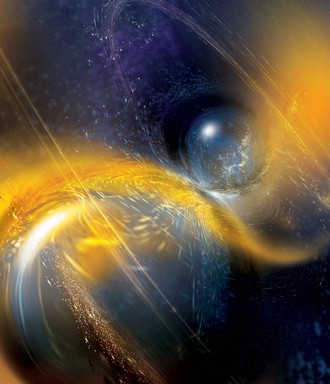
On January 6th 2020, the LIGO Scientific Collaboration and the Virgo Collaboration announced GW190425, the first reported detection of gravitational waves from the third observation period, O3.
On April the 25th, 2019, the network of gravitational-wave (GW) detectors formed by the European Advanced Virgo, in Italy, and the two Advanced LIGO, in the US, detected a signal, named GW190425. This is the second observation of a gravitational-wave signal consistent with the merger of a binary-neutron-star (BNS) system after GW170817. GW190425 was detected at 08:18:05 UTC; about 40 minutes later the LIGO Scientific Collaboration and the Virgo Collaboration sent an alert to trigger follow-up telescope observations.
The source of GW190425 is estimated to be at a distance of 500 million light years from the Earth. It is localized in the sky within an area about 300 times broader than was the case for the BNS observed by LIGO and Virgo in 2017, the famous GW170817, which gave birth to multi-messenger astrophysics. This is due to the fact that the GW190425 signal was only detected with a high signal-to-noise ratio by LIGO at Livingston. At the time, the LIGO Hanford detector was temporarily offline, while the signal reconstructed in Virgo was weak, because of a difference in sensitivity with respect to LIGO Livingston and because of the likely direction of origin of the signal: a region of the sky in which Virgo was less sensitive at the time the signal arrived on Earth. This less precise sky localisation makes it very difficult to search for counterparts (electromagnetic signals, neutrinos or charged particles). Indeed, unlike GW170817, no such counterpart has been found to date. Nevertheless, Virgo data have been subsequently used to improve the characterisation of the astrophysical system.
There are a few explanations for the origin of GW190425. The most likely is the merger of a BNS system. Alternatively, it might have been produced by the merger of a system with a black hole (BH) as one or both components, even if light BHs in the mass-range consistent with GW190425 have not been observed. Yet, on the basis solely of GW data, these exotic scenarios cannot be ruled out. The estimated total mass of the compact binary is 3.4 times the mass of the Sun. Under the hypothesis that GW190425 originated from the merger of a BNS system, the latter would have been considerably different to all known BNS in our galaxy, the total mass range of which is between 2.5 and 2.9 times the mass of the Sun. This indicates that the NS system that originated GW190425 may have formed differently than known galactic BNSs.
Astronomers from CAMK PAN, Michał Bejger, Tomasz Bulik, Paweł Ciecieląg, Marek Cieślar, Brynmor Haskell, Filip Morawski, Magdalena Sieniawska and Ankan Sur are members of LIGO-VIRGO team.
More details: on VIRGO and LIGO pages
Original paper: "GW190425: Observation of a Compact Binary Coalescence with Total Mass ∼ 3.4 M⊙"
Picture: artistic vision of the event.






